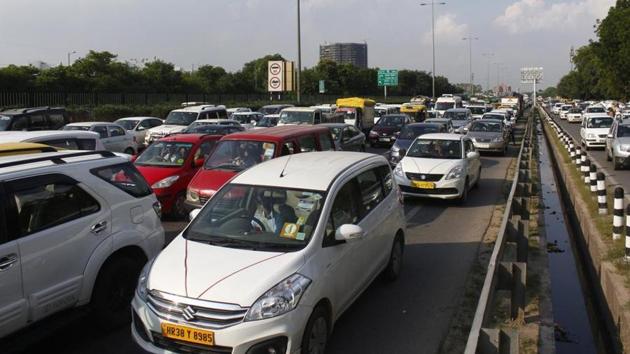Over half of inbound traffic enters from Sirhaul, Kherki Daula
About 1.68 lakh vehicles enter Gurugram from Delhi at the Sirhaul toll and approximately 83,026 enter the city from Kherki Daula toll daily between Monday and Friday.
About 4.47 lakh vehicles enter Gurugram from 11 border points on every weekday with more than half of them using the expressway at two toll plazas at Sirhaul and Kherki Daula, states the draft Mobility Management Plan released by the Gurugram Metropolitan Development Authority (GMDA) on Sunday for public feedback.

About 1.68 lakh vehicles enter Gurugram from Delhi at the Sirhaul toll and approximately 83,026 enter the city from Kherki Daula toll daily between Monday and Friday. Though the stretch between the two toll plazas accommodates 56% of the total traffic inflow into the city, it only makes up for 2.09% of its total road length of 953km, reveals the plan.
“The downside of improper planning of Gurugram is that the expressways are serving as an arterial stretch instead of a master road. It has been designed in a manner that it not only carries traffic between the two cities, but also ferries motorists from one corner of Gurugram to the other. Hence, it is heavily congested and a constant snarl point,” said Sewa Ram, an urban transport systems design expert and a faculty member at the School of Planning and Architecture (SPA), Delhi, which has prepared the draft CMP the behest of GMDA.
The CMP further states that the highest volume of peak hour traffic movement is between 10-11am on the Delhi-Gurgaon Expressway when 19,690 vehicles travel cross the stretch.
For the stretch between Manesar and Kherki Daula toll, the peak traffic hour is 6.15-7.15pm when 11,989 vehicles move on it.
The MG Road has the highest traffic flow between 9.15-10.15am when 8,821 vehicles travel.
As per Sewa Ram, traffic volume count was conducted continuously for 24 hours on 11 weekdays, which did not have any public or restricted holidays, for noting the traffic volume entering and leaving Gurugram. Following this exercise, the data was collected and the traffic volume tabulated.
In addition, the CMP gives details of how the city’s road network is distributed, the number of lanes, road width and the average speed on the stretches.
Arterial stretches, in common language, are main roads that carry high capacity of urban traffic from collector roads to the expressways. Sub-arterial stretches are arterial roads carrying traffic to developing areas such as the new sectors of 58-115.
Collector roads are mainly residential and colony roads carrying traffic towards arterial or sub-arterial stretches.
The CMP further states that 64% of the roads are either 2-4 lane stretches, while the remaining 36% are 6-8 lane stretches. It goes on to state that only 20% of the roads have streetlights.
In terms of right of way, 31% of roads are less than 15 metres wide, while only 26% of roads have carriageway of more than 45 metres.
On 51% of road network people drive at an average speed of 0-30 kmph, whereas on 11% of length drive at an average speed of greater than 60kmph.

Stay updated with all the Breaking News and Latest News from Mumbai. Click here for comprehensive coverage of top Cities including Bengaluru, Delhi, Hyderabad, and more across India along with Stay informed on the latest happenings in World News.
Stay updated with all the Breaking News and Latest News from Mumbai. Click here for comprehensive coverage of top Cities including Bengaluru, Delhi, Hyderabad, and more across India along with Stay informed on the latest happenings in World News.





